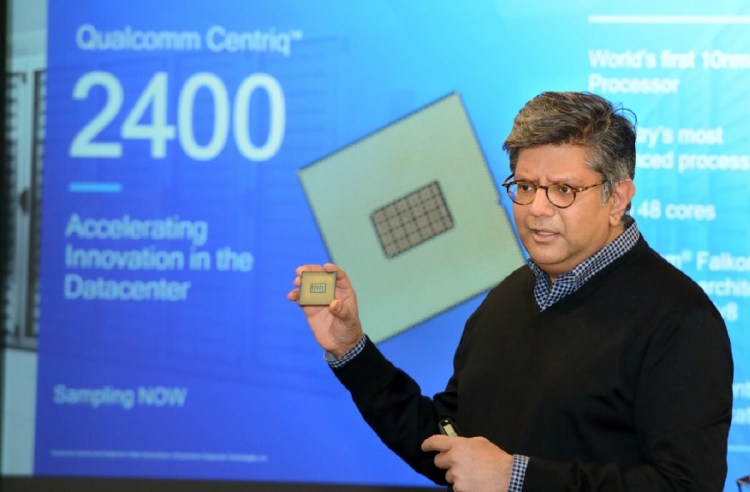Qualcomm is on a mission to dislodge Intel from data center servers. And it is taking a step forward in that mission today with the announcement of an ARM-based server chip with 48 cores that is made in an advanced 10-nanometer manufacturing process.
The news is potentially significant, as it marks a key milestone in a “marathon” war with Intel. Qualcomm has been working on the project for about four years and is announcing today that it has produced engineering samples of chips with 10-nanometer circuitry. That means the circuits are 10 nanometers (a nanometer is a billionth of a meter) apart, which is a level that chief rival Intel has only just begun talking about. It also suggests that mobile technology, and not just PCs, is driving the underlying semiconductor industry forward.
Anand Chandrasekher, senior vice president and general manager of Qualcomm Datacenter Technologies, said in an interview with VentureBeat that he believes Qualcomm and its foundry (contract manufacturing) partner are ahead of Intel in being able to show working 10-nanometer chips. (Intel announced its own samples for 10-nanometer chips in October.) No doubt the two chip giants will fight about who gets into the market with 10-nanometer technology first.
“What is exciting for us is there are a number of structural changes taking place in the industry,” Chandrasekher said. “The cloud is gobbling up server production, and that affects the supply chain and software ecosystem. That, in turn, allows for new entrants into the data center market.”
The Qualcomm Centriq 2400 family of chips will have up to 48 custom ARMv8-compliant cores, targeting compute-intensive data center applications that require power efficiency. The chip uses FinFET technology, or the same kind that Nvidia uses in its newest Pascal-based graphics chips. Chandrasekher said the chip is designed to target data center workloads.
“For years, process technology was driven by PC processors, as the leading consumer category,” he said. “That started to change, as the smartphone drove the industry forward. The device driving demand for chips forward is mobile. The benefits used to accrue to Intel, which was able to use the volume technology to drive the defects out and hit lower costs. This is a massive change in the industry, as those benefits now accrue to the foundries making mobile chips.”
Qualcomm Datacenter Technologies demonstrated Apache Spark and Hadoop on Linux and Java running on a machine with a Qualcomm Centriq 2400 processor. The Qualcomm Centriq 2400 processor series is now sampling to key prospective customers and is expected to be commercially available in the second half of 2017.
That’s a long time from now, and it gives Intel time to be the first to move into the market, but speaking generally, both companies will have 10-nanometer chips in the market around the same time. Intel will be touting its x86-based server chips, such as its Xeon family, while Qualcomm will offer a low-power alternative with its ARM-based chips.
Chandrasekher said that Qualcomm first announced the project in 2014 and that a bunch of tools were made available last year. Those tools will help software makers develop data center software to run on the chips by the time they hit the market late next year. Qualcomm isn’t yet saying which contract chip manufacturer is making its chips.
“Our target is the mega data center customers today,” Chandrasekher said. “The opportunity here will open up over time. It’s not a sprint. It’s a marathon. But it is a very good marathon to be in.”
VentureBeat's mission is to be a digital town square for technical decision-makers to gain knowledge about transformative enterprise technology and transact. Learn More

